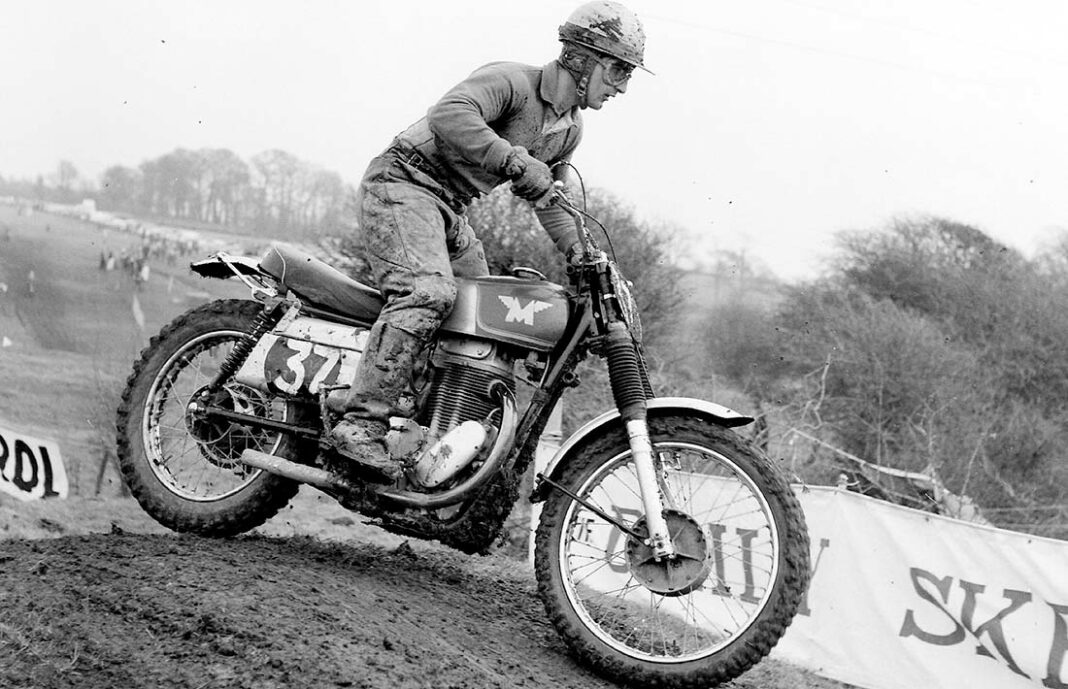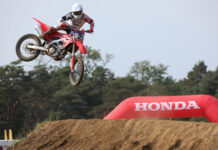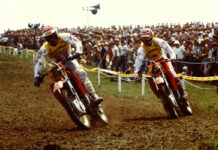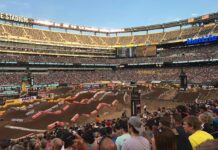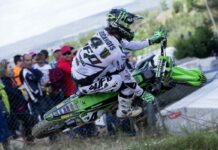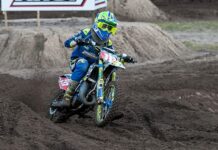From Russia to the USA – there was absolutely nowhere in the world where scrambling ace Chris Horsfield wouldn’t race…
The scene is the Russian steppes in the early summer of 1966 and the lights from a hundred camp fires glint out across the endlessly flat landscape. A huge caravan of gypsies has pulled up for the night and their camp is alive with dancing and the aroma of freshly cooking food. Among the travellers are four faces who are unmistakably those of ‘foreigners’ – two Brits and a pair of Swedes.
You might be forgiven for thinking this is a plot from a spy movie however the Romany’s guests are not secret agents but a quartet of international motocross riders – Chris Horsfield, Jerry Scott, Rolf Tibblin and his fellow countryman Per-Olaf Persson. They’re on their way to the Russian GP and frustrated by their Soviet minders’ sluggish rate of progress have decided to press on independently. Remember it’s the height of the Cold War so four westerners on their own behind the Iron Curtain would almost be enough to trigger an international incident!
The roads across the barren steppes are straight and boring, so faced with a dearth of a suitable cafés and hotels they opt to join the surprised gypsy folk – a meal of roast goat and a night under the stars the reward for Horsfield and co. Chris laughed as he recalled the incident although his memory was tinged with some sadness as just a few weeks later his close friend and travelling companion Jerry Scott was tragically killed while racing in the North Vs South scramble at Thirsk.
By 1966 CZ mounted Chris had become an established works rider and courtesy of his success in the Grandstand and World of Sport TV scrambles a household name.
His racing career started in 1957 on a BSA B32 but racing motorbikes was not Chris’ first ambition. “I was brought up in the era of great racing drivers like Fangio and as a young boy dreamed of following in his footsteps. My mother and father were friendly with the Moss family and I remember a fantastic day when we were all invited along to Silverstone where Stirling and Mike Hawthorn were testing.
“In his yellow polka dot Dickie bow Mike Hawthorn was a great character and as I soon discovered a great practical joker, especially where Moss was concerned. Stirling came back into the pits and said he couldn’t believe how narrow the track seemed in the area controlled by cones but what he didn’t know was that Hawthorn had been closing them up and before he had pitted he’d opened them up again.
“Moss said that the car was so easy to drive a kid could do it so Mike, who scoffed at the notion wagered him £10 on it – as I was the only kid I was stuck behind the wheel of the Formula One car and on my first ever drive won Moss the bet! I told him I wanted to become a racing driver but his answer was ‘forget it unless you’ve got plenty of money’. It was then I decided I would opt for two wheels instead of four.”
The young Chris soon became the proud owner of an old James – a machine on which he learnt the art of off-road control although it also earned him a ticking off from the long arm of the law.

“I was 14 and riding the James through the lanes to the fields. Normally this was fine but one day I came upon a police roadblock – somebody had done a runner from the nearby asylum and they were out looking for him. It was obvious I wasn’t old enough to be on the road so they turned me round and followed me back home in the police car. I thought I would be nicked but because they’d told me to ride it home it would have been seen as aiding and abetting so I was let off with some finger wagging and a stern lecture.”
At 16 Chris started work on a farm and the James was pensioned off – the little two-stroke replaced by a B31 BSA which he rode to watch his first scramble.
“Rob and Sam Cooper and I went to watch the scramble at Knowlsworth, a top line event which featured people like John Draper, Geoff Ward, Brian Stonebridge and a young chap called Jeff Smith. I just couldn’t believe how fast they were going.
“It was there and then I decided to be a scrambler although Sam and Rob thought that I was joking when I said I gave myself three years to become a professional rider. It’s not surprising that they laughed because at that time there were very few able to earn a living wage from racing motorbikes.”
At this stage Chris had never even sat on a scrambler let alone ridden one but not to be deterred he soon had his first bike – a BSA B32 which cost £150.
“The BSA dealer in Stratford was surprised when I told him I wanted to buy the B32 and kept reminding me that it was a competition bike and I wouldn’t be able to ride it on the road. I couldn’t kick it over let alone start it but when he realised I was serious allowed me £30 on the B31 and the rest I took up on hire purchase at £1 a month.”
In his state of ‘must have it’ Chris had given little consideration to how he might get the Goldie home so with no transport available the only option was to push it the three and a half miles from the centre of Stratford! It transpired that the Goldie had previously been raced by Ron Langston so it was an optimistic Chris who in 1957 lined up for his first race.
“The Cooper brothers and I had decided to pool our resources and we’d bought an ex-army A40 pick-up truck. It was a bit of a heap and before we could drive it away we had to weld the doors up, this meant that the only way to get in was through the windows! We then discovered that of its three gears it was only first and top which selected but amazingly it got us to my first meeting at Kimber Edge near Stourbridge.”
After he disappeared through a hedge Chris’ debut race ended in retirement however on his second outing of the afternoon he gave a hint of his potential when he brought the Goldie home fifth in a race won by Bull Baraugh on the works DOT.
“I rode in about five events during the latter half of ’57 and I fell off more than I stayed on – it was certainly a lot harder than I could possibly have imagined”.
Farm workers pay was pitifully poor and for Chris it was hard to finance his passion for scrambling. His 5/s entry fee, petrol and bike upkeep all had to be paid for by a weekly wage of £3.00. It probably comes as little surprise to learn that by 1958 he had left the farm and was working in a local garage run by the Bollom family – the change of vocation hastened when he crashed his former employer’s tractor though a hedge.

He was getting on the pace but due to its huge carburettor the Goldie had little in the way of bottom-end power. Once under way it went like the wind but invariably Chris was last away which meant playing catch up – youthful over exuberance resulting in the almost inevitable crash. 1958 was an eventful year and for much of the time he was either dicing for the lead or falling off but the following season a new bike soon brought its rewards.
“If I was going to reach my three year goal of becoming a works rider I had to have a decent bike or pack up. I decided to put my money where my mouth was and bought myself a brand new B34 Gold Star which cost a whopping £378. I soon started winning and it was a fantastic year for prize money and silverware. By then I was travelling to events as far afield as Derbyshire and Wales in a shared van with Bonzo Harris and Terry Player who acted as mechanic.”
From his earliest days Chris has kept carefully chronicled records of his career and they reveal that in that 1959 season he was winning about £30 a week in prize money. A decent return when you consider the average wage was then about £10! His riding ability was starting to get him noticed and he was chosen to compete in the annual Oxford versus Cambridge scramble.
“It was a great honour to be chosen for the Oxford side, I had a good event and although I didn’t win I managed to beat Brian Stonebridge although he was riding a 197cc Greeves and I was on a 500cc BSA. I’d been racing two and a half seasons and really thought I’d made it but was brought down to earth the following year.
“1960 turned out to be a bit of a nightmare and I was forever crashing – one was so bad it bent the Goldie’s frame. It needed replacing so we stripped it down and my dad took it on the bus to BSA where competition chief Bert Perigo gave him a new one.”
He soon returned to his winning ways and attracting the eyes of a sponsor. “A chap in Coventry invited me to ride a TriBSA and a Greeves Hawkstone which was my first two-stroke. I just couldn’t get on with the power delivery of the Triumph twin engine and only rode it once. I landed from a jump and the jolt must have done something to the carb because when I shut the throttle back it was spitting so badly it caught fire and I had to bale off at around 50 mph.”
He may not have liked the TriBSA but he took to the little Greeves like a duck to water and on his first outing won a snowy TV scramble in Derbyshire. Although getting to the venue was not without its problems.
“Bob and Sam were due to pick me up at 6.00am on the Saturday morning but overnight there had been a heavy snowfall so the lane to my village was impassable. I loaded up my kit bag and started pushing the Greeves but the drifts were too deep so the only option was to start it. It was fitted with one of those flat megaphones so as you can imagine it was horrendously noisy riding it through the village. We eventually loaded up but the A40 didn’t have a heater and because of the treacherous going we only arrived in time to do one lap of practice. Despite this I quickly adapted to the snow and surprised myself winning the first TV race.”
Sadly before he could taste the fruit of further success the sponsor went bust so once more Chris was without a bike to ride. This was short lived and soon he was lined up to ride the ex-Ron Langston works Ariel – a bike bought by Bert Lavis after Langston had retired with a back injury.
“My first event on the Ariel was another TV scramble and it was a revelation after my Gold Star. It was light and went like a rocket ship although it didn’t handle as well as the BSA. The peaty going was just to my liking and in the race I finished second to Jeff Smith.”
It was one of Smith’s first races against the young Horsfield and on arrival back in the pits is reported to have asked ‘who is that mad little bugger?’.
Again the association with the Ariel was short lived – after four or five races Chris landed from a jump and on impact the frame broke in half.
“It split at the head and I cart wheeled down the track – I’ve still got the tyre marks on my back to prove it. It went back to Selly Oak to have a new frame fitted but while it was there they took out all of the good bits so on its return it was just a stock and rather uncompetitive bike.”
For a while Chris considered retiring but again lady luck intervened in the form of Norman Houghton. Norman was the competition manager for Lodge plugs and invited Chris to ride and help develop a bike he was involved in. After meeting Norman, Chris agreed to ride the bike although at that stage it hadn’t even been built!
“A few weeks later I got a call to say that it was ready so the first time I actually saw the bike was on the Sunday I turned up to race it. It had a 197cc Villiers engine, a small section 3.50 rear tyre and looked more like a road bike than a scrambler! I raced it two or three times but it was absolutely dreadful.
“Then out of the blue I got a phone call from Bob Bicknell who was the sales manager for James and Francis Barnett. He told me there was a position available at James and it was mine if I was interested. I was still working in the garage on a wage of about £7 a week so James’ offer of £11 seemed like riches in comparison. It involved a round trip of 40 miles but I decided to take it.”
Chris spent the first two weeks working in the underground workshop building wheels, welding and road testing but he then got a call to go to the comp shop. James had been hoping to sign Sammy Miller to help develop the Commando trials bike but for reasons unclear this didn’t happen so Chris was invited to develop and ride the scrambler.

“I was working with Eddie Kees who was a brilliant mechanic and could make virtually anything. Two-stroke tuning was still a bit of an unknown art so we experimented with the Villiers engine padding the crankcases and fitted a Parkinson conversion which got it going really well. Although we didn’t realise it at the time it was the infancy of the Starmaker engine.”
Much to their surprise Chris and the James started winning although between races the bike was totally stripped and rebuilt for the following weekend. And it turned out it wasn’t just the bike that was stripped down!
“The James machine shop was largely run by women and like something out of the 1930s with huge machines driven by exposed belts. I was starting to get some good results and on my way to the comp shop the women would sometime whistle or shout out. However, one day I was aware that the whole room had an eerie quietness about it. Before I knew what was happening I was surrounded by a group of baying women who proceeded to strip all my clothes off and I had to run naked to the safety of the comp shop! Needless to say I didn’t go that way again!”
Chris was perhaps not the most naturally gifted rider but what he lacked in skill he more than made up for in stamina and a typical day involved a three and a half mile run before he started work. He might have been a works rider but he still had to clock in at 8 o’clock every morning!
He was soon on the trail of the continental GPs but his championship ambitions met with little enthusiasm from his employers.
“We got the James going really well so I thought that the GPs was the natural progression but when I asked they said ‘you’ll have to pay for it yourself’. So I went ahead and managed to get a ride in the 1962 Swiss GP – this was my first trip abroad. Although I had to pay for it myself they let Bob Cooper go as my mechanic and we made the long two and a half day trip to Payerne along with journalist Chris Carter. Our ‘race transport’ was an old Ford Thames van which I bought for 30 quid and this also acted as our overnight accommodation.”
At that time Horsfield was an unknown outside the UK although at the impromptu pre-race party he became the centre of attention.
“Jan was expecting and after about four laps of practice I was pulled off the track to receive a telegram announcing that Grant had been born. The Russians and Czechs threw a massive party to celebrate and with the help of Sten Lundin and Andy Lee I eventually managed to send a return telegram.”
In the race Chris also did rather well and finished a creditable fifth despite having to ride half the race without a seat. His employers may not have given much in the way of encouragement or support for his trip to Payerne but later they sold 80 bikes to the Swiss importer as a result of his success! Throughout his career Chris had suffered a number of heavy crashes but undoubtedly one at Hawkstone in late ’62 was the worst.
“Although the James didn’t handle as well as the Greeves or BSA opposition the Starmaker engine was very quick and I was involved in a dice for the lead with Jeff Smith. We came out of the sandpit absolutely flat out onto the straight and the next thing I remember was waking up in bed. Apparently I got flipped off and collided with the fencing – it resulted in bruising to the brain and I had to stay in a darkened room for six weeks.”
Not to be deterred Chris was soon back in the saddle although this time on a booming 500cc Matchless.
“Dave Curtis was retiring so they asked me if I’d like to take over his bike, as you can guess the answer was ‘blimey, yeah!’. I think Hugh Viney looked upon it as his baby and before my first ride at Rolsworth he gave me strict instructions of ‘don’t crash and don’t damage it’! It didn’t handle particularly well but the engine turned out the best part of 50bhp so it was an absolute rocket ship good for close on 100mph.”
In addition to Dave Curtis, Geoff Ward and Gordon Blakeway were also coming to the end of their careers so Chris joined a new team which comprised of himself, Vic Eastwood and Dave Nicoll to fly the Matchless flag. It was something which for the next three years he achieved with great aplomb although Viney was ever watchful. After one race Chris found a note pinned to the bike which read ‘change up or else!’.
“They were fantastic days although riding in the GPs was very demanding. The season started in Austria and then went on to Monza in Italy. From there we would drive all the way up to Finland, Sweden, Denmark and Germany before coming home for six weeks. It might sound romantic but we had to drive thousands of miles and between races had to do all our own maintenance on the bikes and keep to our training schedule.”
However, it was not all work and no play for the Brits chasing world championship honours and they did find time to let their hair down.
“After we’d raced in the Austrian GP we met an old guy who’d fought in the war but was now keen to celebrate peace and friendship with his former ‘enemies’. A group of us including Jerry Scott and myself were invited to his home which, as it happened had a room licensed to sell home brewed wine and liquor. Around the room ran a ‘dodo rail’ and after a few (read several) glasses of schnapps the Austrian displayed his ‘party trick’ of running around it. By this time it was two o’clock in the morning and we’d all partied well but none of us including Jerry or myself could manage it – this was particularly frustrating because the Austrian was 80 if he was a day. I think it was another 20 years or more before I could face another glass of red wine!”
The works Matchless was in Chris’ words “like a rocket ship” but compared to the opposition massively heavy and the riders request to lighten things fell on deaf ears with Hugh Viney. However away from the bosses’ prying eyes things did get done.
“A resourceful group of ex-Norton comp shop ‘old boys’ joined us from Bracebridge Street and no job was ever too much trouble or too difficult for them. We had special innards made for the front forks, electron brake plates, lightweight rockers and a clutch turned out of a solid billet of aircraft alloy. It shaved an amazing seven pounds off the weight of the standard clutch which had been struggling to deal with the engine’s huge torque. It made the world of difference and when married up to a lightweight Swedish gearbox the bike fairly flew.”
There was no disputing the bikes performance but around the paddocks there were murmurings that after its visits to the comp shop the half-litre single’s displacement sometimes ‘grew’ an extra 100cc. Rumours which always led to tight lipped denial from comp shop bosses and never proven.
The Grand Prix riders were a close knit crowd and during the long season would often play host to their on track rivals between races, help with some chores the usual ‘payment’ although this was not the case in Sweden.
“We’d ridden in Finland – where I was horrified to pay £4 10s for breakfast – and before the Swedish round Rolf Tibblin invited me, Jerry Scott and his father Len to stay at his (Rolf’s) family’s home in Stockholm. Tibblin senior was a scrap metal man and told us that anyone who stayed in his house was welcome but were expected to work for their keep. I wasn’t sure what he had in mind but we were woken at 5.30 in the morning and after breakfast put in a really long, hard day helping him to dismantle a huge road bridge over Stockholm harbour.”
Ernie Wiffin had taken over as competition manager from Hugh Viney but all was not well with the AMC parent company and Chris was given the tipoff that he should start looking around for another ride. This was the back end of 1964 and BSA were celebrating Jeff Smith’s 500cc world championship win on the lightweight 440 victor. It was a machine ideally suited to Chris’ full-on riding style and after a meeting with Brian Martin it looked like he’d landed works bikes for ’65, although it didn’t quite turn out as planned.
“Brian Martin offered me a brace of works BSAs (250 and 500) for the 1965 season but a week before I was due to pick the bikes up pulled out of the deal.”
The ‘official’ reason given for this change of plan was that ‘Matchless and BSA had an agreement not to sign each other’s riders’. However the feeling with those ‘in the know’ was that one of BSA’s top riders viewed Horsfield as a serious threat to his own championship aspirations and simply didn’t want him in the same team therefore vetoing his ride.
Struggling to get the best out of the Matchless, Chris had turned to the Rickman brothers and bought one of their frames to house the works engine although AMC themselves had also announced a ‘new’ machine.
“Derek Rickman had already shown that with a decent frame the Matchless could still be competitive so I got Bob Cooper to prepare it and fabricate some titanium engine plate’s ready to slot the works engine straight in without interrupting my racing schedule.
As you can imagine it was a revelation after the works heavyweight and weighed in at 278lb! Matchless were also keen to show off their new scrambler which if nothing else certainly looked the business.”
There was no denying its purposeful appearance but as Chris revealed design, testing and costing of the new machine left a lot to be desired.
“The frame had been designed around a chalk outline drawn on the floor at Woolwich and although it looked fantastic it didn’t handle at all well and Vic Eastwood’s father immediately went about cutting and modifying the rear end and steering head angle.
“It was wheeled out for the attendant press pack who made all the right sort of noises but when questioned how much it was going to cost Bill Smith passed it on to Ernie who replied ‘got to be worth £279 of anybody’s money’. I got the impression that up to that point there had been little or no thought given to the cost and it was figure which was just plucked out of the air!”
Join us next month for the second part of the Chris Horsfield story that sees the scrambles superstar help develop Kawasaki’s first off-road racer and later head to the USA…



